Classic Seafood Paella is a delicious meal to serve on special occasions to family and friends. This Spanish one-dish meal is loaded with seafood flavors and floral saffron.
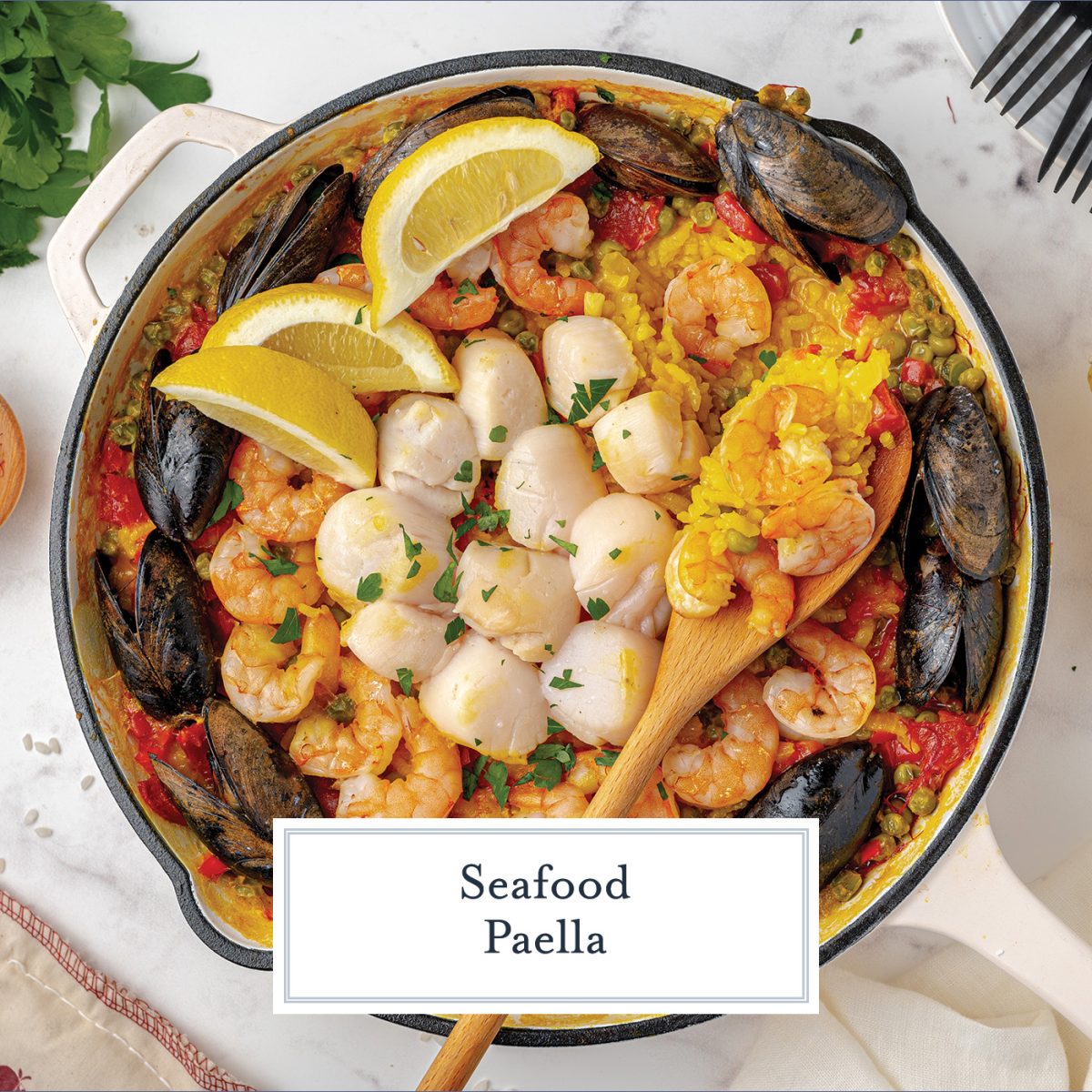
If you’re a seafood lover, you’ll adore this easy paella recipe. We will give the home cook an easy, step-by-step paella for the paella novice suited for cooking on the stove top, not an open flame in the backyard.
What is Paella?
Paella is a Spanish dish often made with rice, seafood, chicken, and saffron, which are cooked in a large, shallow pan. I’ve had amazing family-style paellas out and about and wanted to try it at home.
Seafood Paella isn’t actually classic. Paella was first cooked over wood fires in the fields of Spain and made with rabbit, chicken and snails. In the states, these flavors probably wouldn’t go over too well.
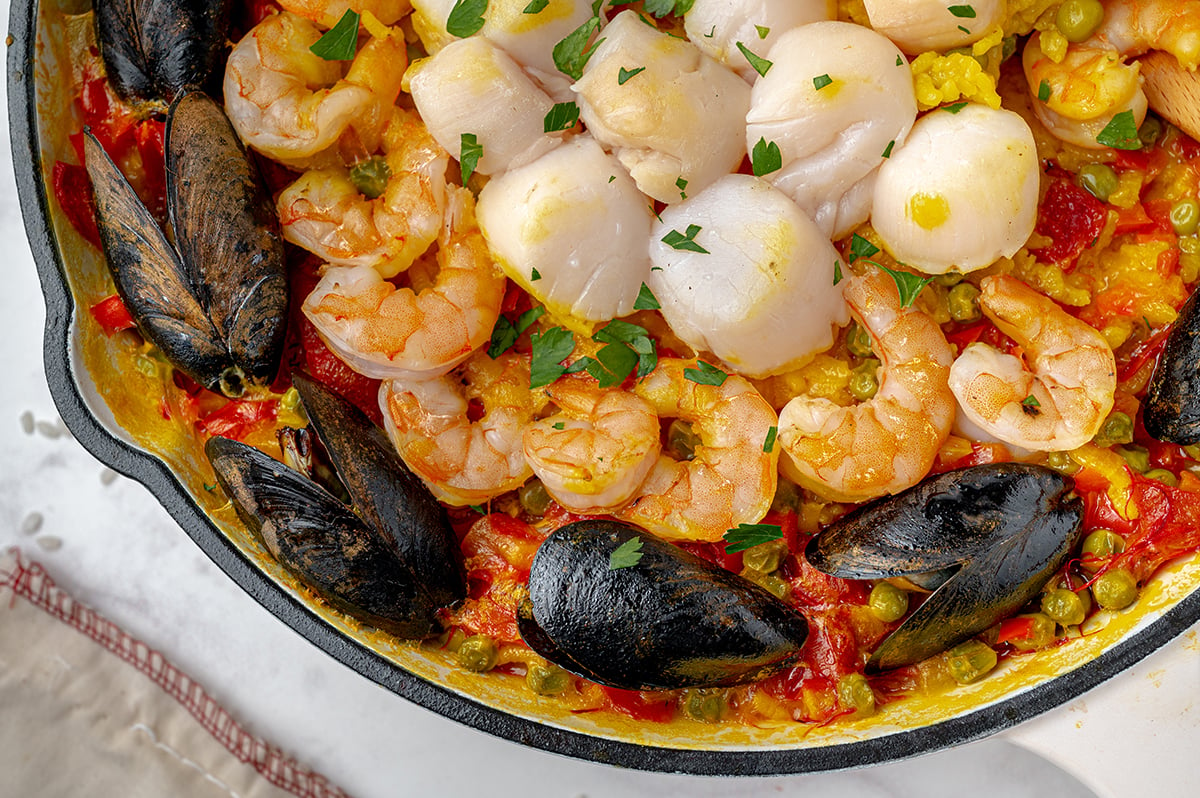
In the states, the most commonly used proteins are clams and mussels, as well as chicken thighs. Seafood stock or chicken broth is used for the rice regardless of the other proteins being added.
Small amounts of saffron were used for fragrance and color, but not necessarily for flavor. Afterall, saffron was expensive and the hue of your rice could symbolize your stature in society. The more you used, the wealthier your family!
Paella Pans
What is a paella pan? Most paella pans are flat, shallow, and made of carbon steel. Carbon steel is an excellent conductor of heat which makes for excellent, even cooking. Tiny divots or simples in the bottom of the pan help to maintain its shape and provide even cooking.
Paella pans are meant for fire cooking- either an open flame, on a grill or even a gas stovetop. They do not work as well and might scald on an electric cooktop.
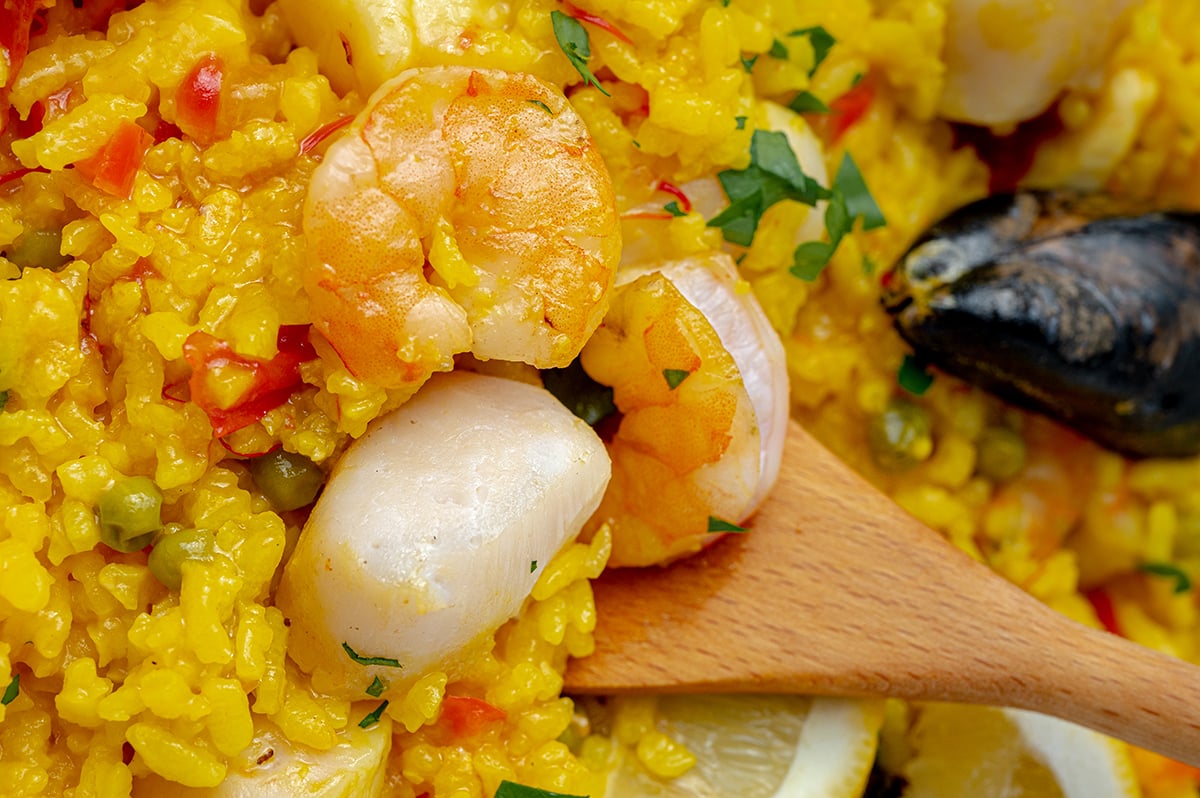
Are there alternatives to paella pans? Surely! Just because you don’t have the special pan or have the ability to cook with fire, doesn’t mean you can make delicious paella at home. The best alternative to a paella pan is cast iron. Also a great conductor of heat, it cooks evenly and is oven safe should you need to swap them back and forth.
Ingredients
The ingredients for paella change from recipe to recipe and like Italian’s with their red sauce, every family has their own “best seafood paella recipe”. There is no one right way, but a million really good ways to prepare it. With the exception of the rice to liquid ratios, the rest of the ingredients can be altered depending on what you have on hand.
- Low sodium chicken broth (chicken stock)- I like using low sodium so I can control the rest of the salt in the dish. Seafood broth, vegetable broth or fish stock can also be used, chicken just tends to have the most flavor.
- Saffron threads- Saffron is one ingredient that makes paella, well, paella. It is an expensive spice but it is a “must” for authentic flavor and color.
- Coarse kosher salt- This salts is the least salty, but still helps to balance and accentuate natural flavors.
- Olive Oil– Spanish olive oil is a thing of beauty, but if you don’t want to grab some just to make paella (you can use it for anything else that calls for olive oil), Italian or even American made will do the trick. Look for extra virgin or “first press” for bold flavors.
- Red bell pepper, yellow onion and garlic– Known as the sofrito. Sofrito is a densely flavored sauce that is made by sauteing grated vegetables and spices together. Red peppers are the most authentic, so I don’t suggest swapping for green or yellow bell peppers, although you an add them in addition to.
- Bomba rice (paella rice)– The rice is important! Bomba is the type of rice traditionally used and is a fat, short-grain rice. However, it is a bit hard to find, so I suggest buying it online. You can substitute arborio rice, a short-grain, Italian rice used in risotto, for the bomba as it absorbs a lot of liquid as well. Other types of rice will get too mushy. Bomba rice takes approximately 3 cups of liquid for every cup of dry rice and arborio takes 2 cups for every cup of dry rice. Be sure to modify the recipe if you choose to use arborio.
- White wine– Dry white with pungent floral flavors, preferably a Spanish wine like verdejo, is a key ingredient for authentic paella. If making it sans alcohol (even though the alcohol will evaporate), substitute with more broth.
- Canned fire roasted tomatoes- The fire roasting give a smokey flavor.
- Frozen peas– You can use fresh, but frozen is way easier!
- Smoked paprika– Sweet paprika is the alternative.
- Seafood– People often ask what seafood goes in paella? And the answer is generally, whatever you want! Most seafoods cook at a uniform rate and will added towards the end. I used shrimp, scallops and mussels, but clams, langostinos, clams, lobster tails, calamari and even some fish can all be used too. Just make sure it all equals about 1.5 pounds total.
- Parsley and Lemon– For garnish and optional, but I will tell you that there is nothing better than a fresh spritz of lemon juice on a plate of hot paella.
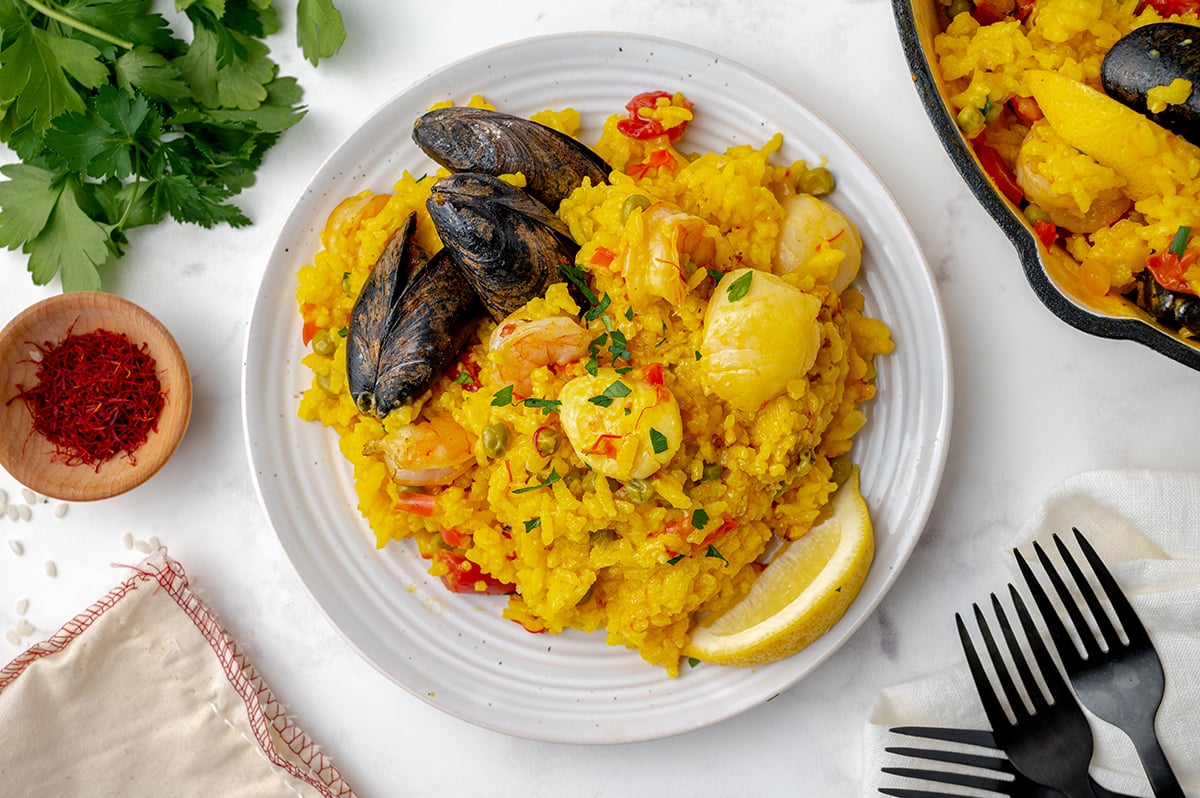
Common variations include adding crushed red pepper for heat, green beans, a bay leaf, whole garlic cloves (creates a garlic confit inside the dish) and tomato paste instead of fire roasted tomatoes.
If you don’t want all seafood, chicken thighs or drumsticks or Spanish chorizo are nice for flavor and taste.
How to Make Seafood Paella
The first time you make it, it might seem a little complicated, but after understanding the whys and hows, you’ll be an expert and able to make any paella variations you want!
- In a large saucepan, heat the broth to a low simmer and add the saffron threads. allowing them to sit and dissolve into the broth and develop flavor. Also add the salt, which helps it distribute evenly. Much like making risotto, heating the broth is important so it doesn’t greatly alter the temperature of the pan while cooking.
- Heat the olive oil in a large skillet (I like cast iron) or paella pan over medium-high heat. Add the bell pepper and onion, sauteing until they are soft and fragrant, then add the garlic. Garlic cooks much faster and has the tendency to burn and become bitter if added with the other veggies. They might be a little mushy, that is fine, we are aiming for a saucy paste.
- Add the olive to the pan along with the rice. Turn rice to coat and lightly brown. Toasting dry rice gives it flavor, just like browning proteins or veggies.
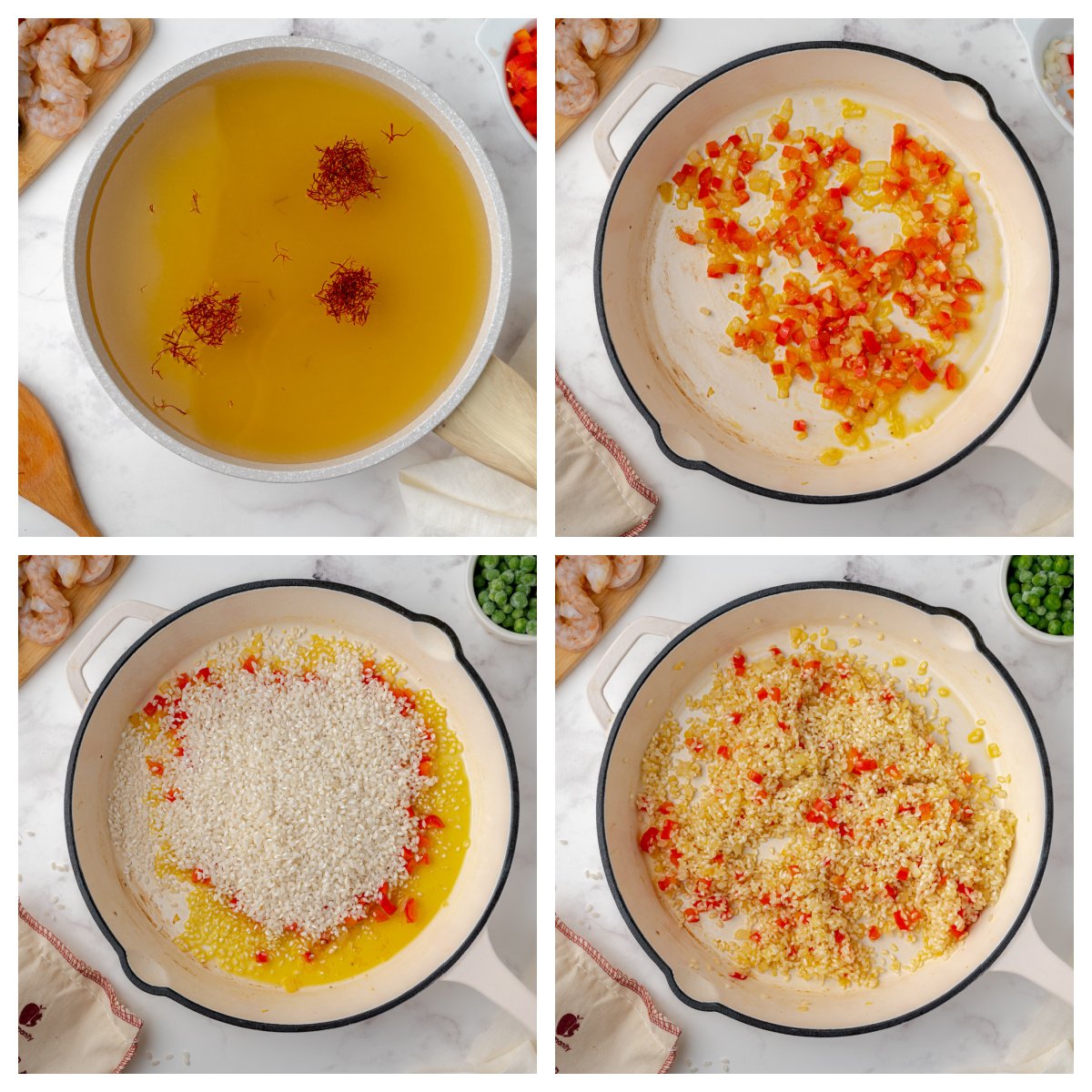
- Add the white wine, cooking until absorbed and letting all those rice grains to become little flavor bombs. Add the tomatoes, peas and paprika. Using the back of your spoon, spread out the rice mixture to a uniform, thin layer. Pour the broth over top of the rice, trying to keep it in a smooth layer to get the best even cooking.
- Cover, use aluminum foil if you don’t have a cover, and cook over medium heat for 15 minutes without stirring, or until the rice has absorbed at least half of the broth. If the mixture looks dry at this stage, add an addition 1/2 cup of hot water. Resist the temptation to stir it while the paella cooks, which is what develops the coveted socarrat, all those browned bits at the bottom.
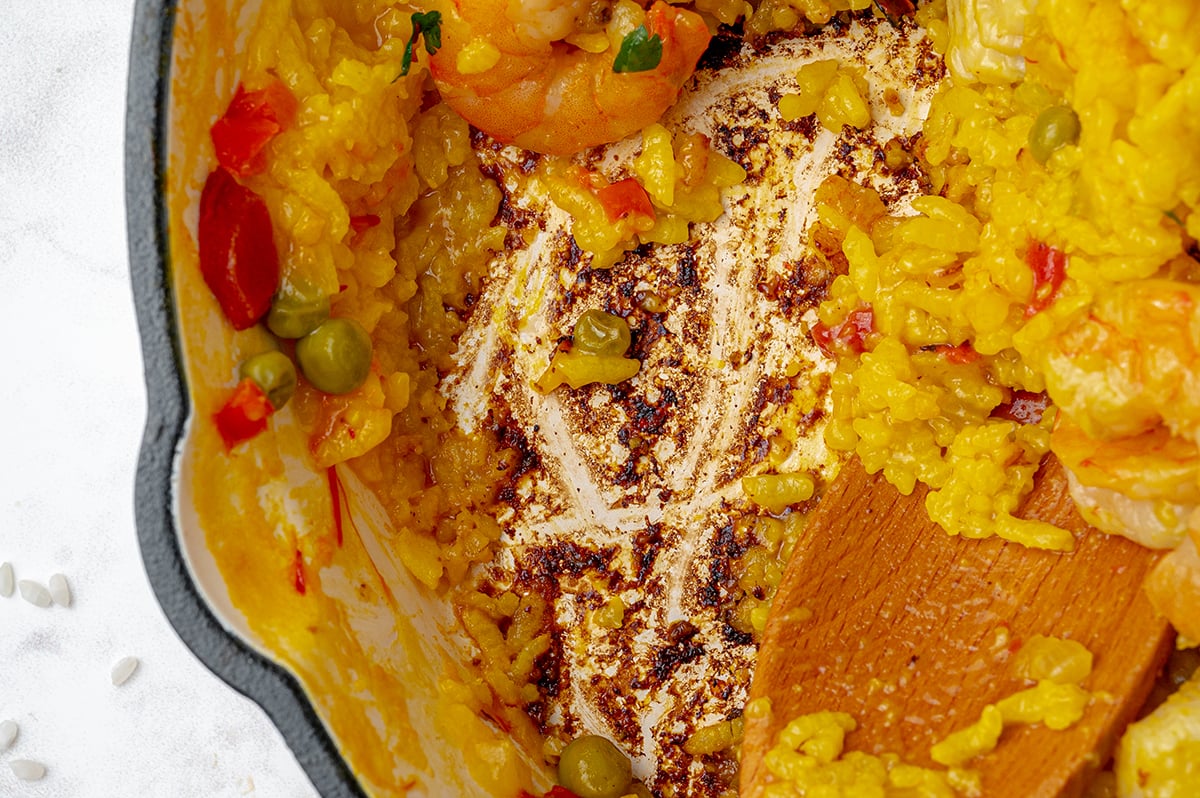
- Arrange the seafood over the rice, slightly nestling it down into the mixture. Place hinged shells with the hinge side up so the juices are released into the rice when cooked, adding even more flavor.
- Cover and cook for an additional 6-10 minutes over medium heat. remove from heat, still covered and rest for 5 minutes, still resisting the urge to stir!
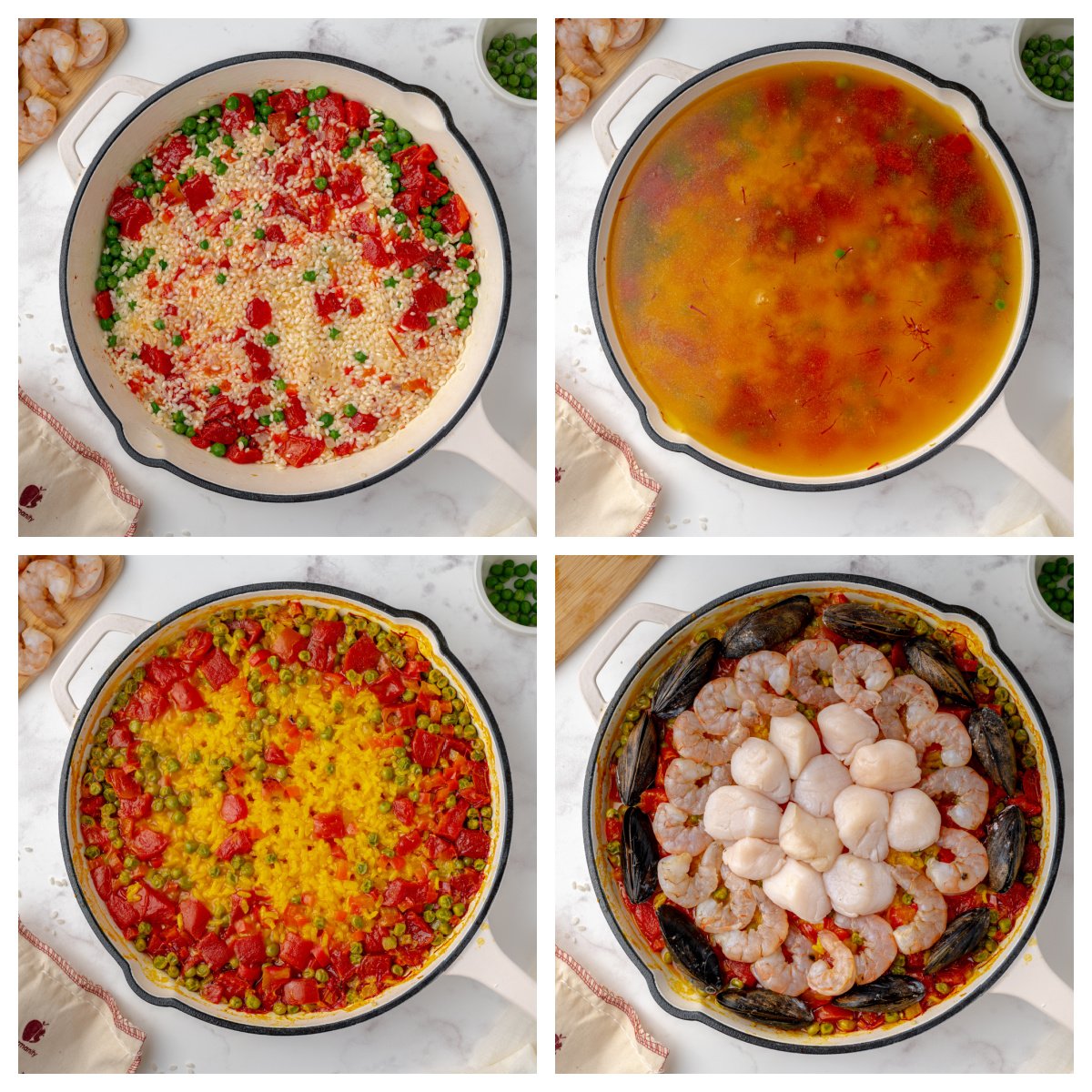
- If any shells did not open, discard them, this means they aren’t any good. When checked with a spatula, the bottom of the rice should have browned and caramelized to a crust, the socarrat.
- Garnish with the parsley and serve with lemon wedges and serve!
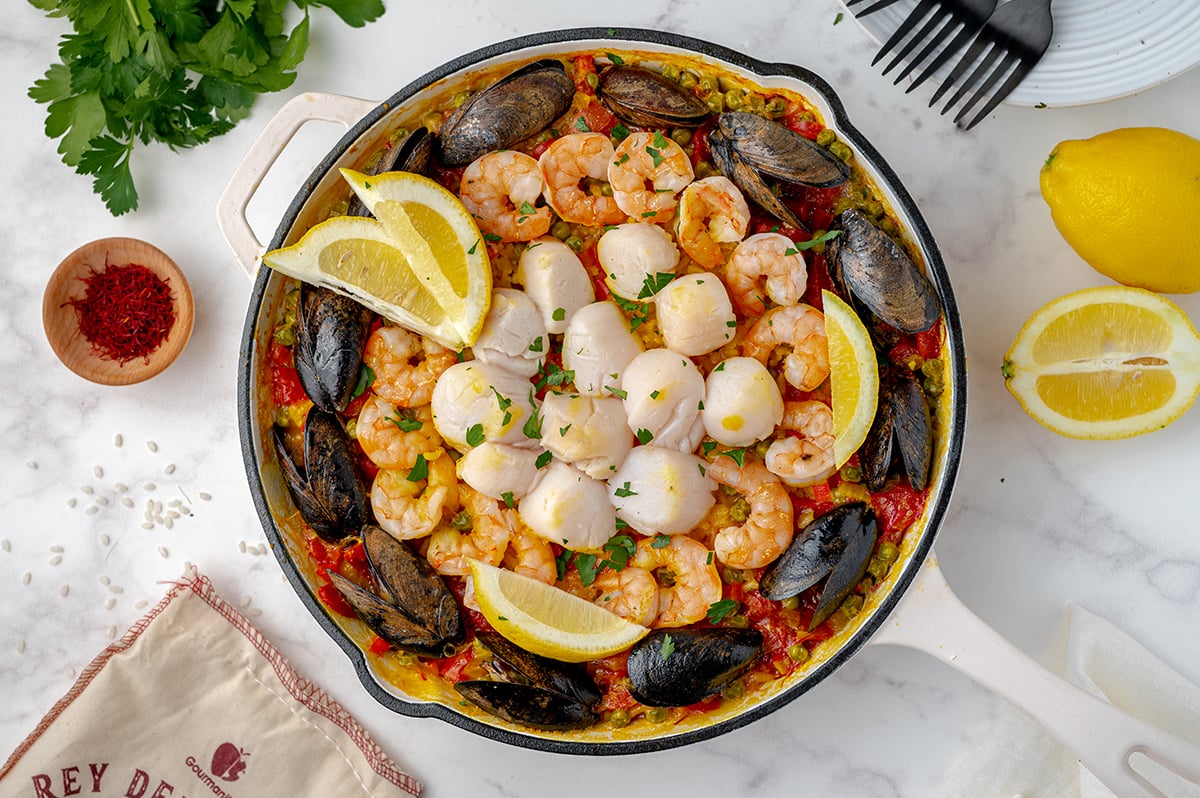
Commonly Asked Questions
The best paella is not known for being spicy. This is a common misconception. Actually, paella shouldn’t be spicy at all. If you like spice, feel free to add a teaspoon of crushed red pepper flakes.
Simply put, tomato sauce with peppers, onions and garlic. It is the foundation to many Spanish dishes, as it rounds the flavour of the stock and provides sweetness and depth to the rice. In this recipe, the peppers, onions and garlic are cooked separate with the tomato added later. This is an easy paella recipe and meant to be a shortcut, we recognize and do not claim this to be “authentic”.
The showstopper of this Classic Seafood Paella is the socarrat, a layer of crunchy, caramelized rice on the bottom of the pan, created by applying high heat at the end of the cooking process. Rice will also cook faster since it is in a thin layer as opposed to being cooked in a saucepan.
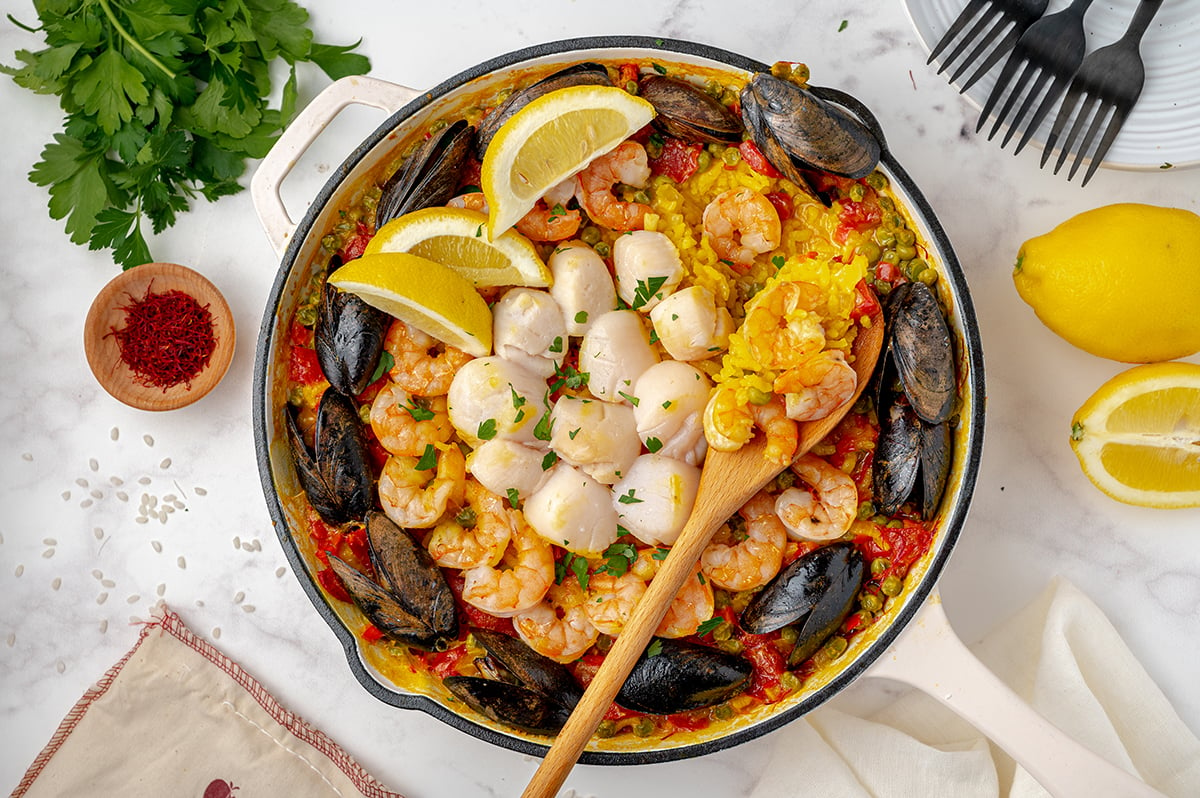
Storage & Freezing
Store all leftovers in an airtight container in the refrigerator for up to 5 days.
How do you reheat seafood paella? Unfortunately, seafood has the tendency to get rubbery when reheated. The best way to prevent this is by gently reheating in a skillet over low-medium heat on the stovetop. You can certainly microwave it, but this increases the probability of it being a little tough, it is unavoidable with this cooking method.
I do not recommend freezing paella. While it is possible, I don’t like re-freezing seafood particularly.
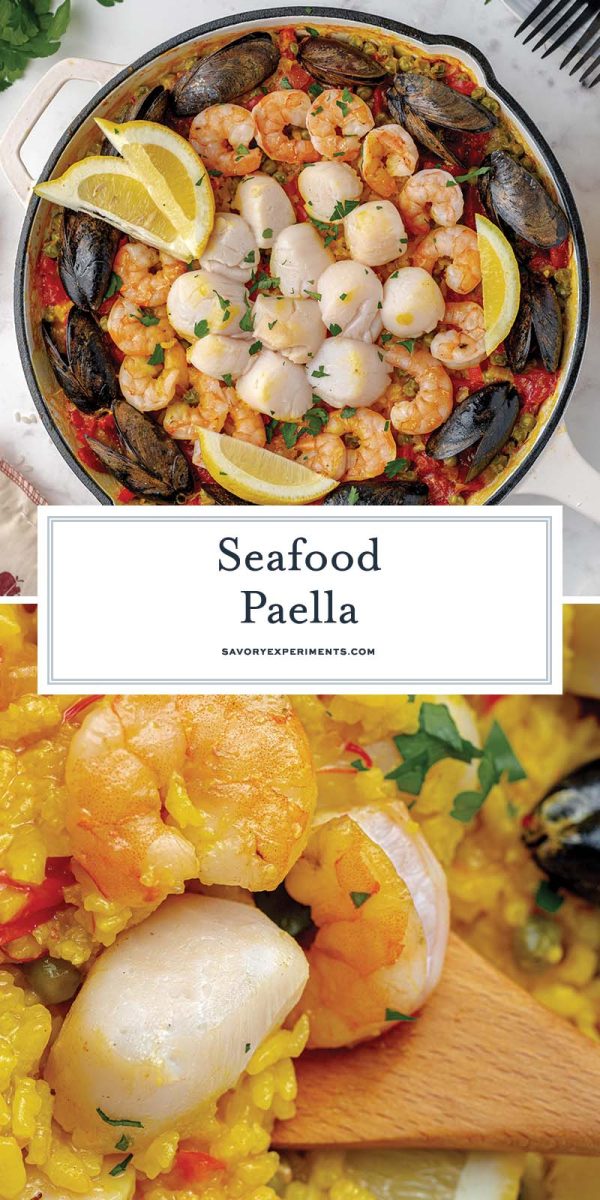
If making paella the classic way isn’t for you, try my super easy Instant Pot Chicken Paella!
Check out these other easy seafood recipes:
Salmon Croquettes Recipe
Asiago Mushroom Salmon
Creamy Shrimp Alfredo Recipe
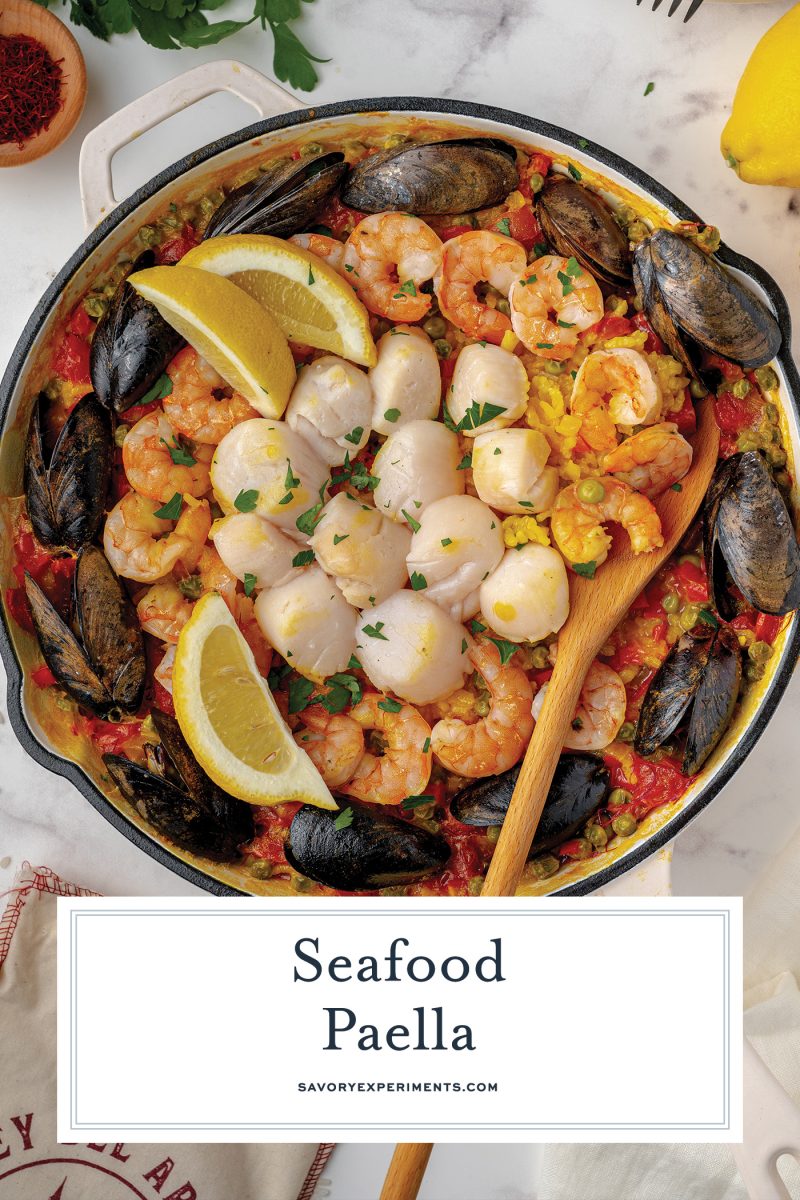
Classic Seafood Paella
Equipment
Ingredients
- 5 cups low sodium chicken broth , or seafood stock if you can locate it
- 2 teaspoons saffron threads
- 1/2 teaspoon coarse kosher salt
- 3 tablespoons olive oil , divided
- 1/2 red bell pepper , finely chopped
- 1/2 yellow onion , minced
- 3 cloves garlic , finely chopped
- 1 1/2 cups bomba rice
- 1/2 cup white wine
- 14-ounces fire roasted tomatoes , canned and drained
- 1/2 cup frozen peas
- 1/2 teaspoon smoked paprika
- 1/2 pound shrimp , peeled and deveined
- 1/2 pound sea scallops
- 1/2 mussels
- 1 tablespoon flat leaf parsley , chopped
- 1 lemon , cut into wedges
Instructions
- In a large saucepan, heat the broth to a low simmer and add the saffron threads. Allow to sit for 15 minutes. Add the salt until dissolved. Keep warm.
- Heat 1 tablespoon of the olive oil in a large skillet or paella pan over medium heat. Add the bell pepper and onion, sauteing for 4-5 minutes or until they start to soften. Add the garlic, sauteing for another 1 minutes.
- Add the remaining 2 tablespoons of olive to the pan along with the rice. Turn rice to coat and lightly brown.
- Add the white wine, cooking until absorbed and mixture is dry again. Add the tomatoes, peas and paprika. Using the back of your spoon, spread out the rice mixture to a uniform, thin layer. Pour the broth over top of the rice, trying to keep it in a smooth layer.
- Cover, use aluminum foil if you don't have a cover, and cook over medium heat for 15 minutes without stirring, or until the rice has absorbed at least half of the broth. If the mixture looks dry at this stage, add an addition 1/2 cup of hot water. Do not stir.
- Arrange the seafood over the rice, slightly pushing it down into the mixture. Place hinged shells with the hinge side up so the juices are released into the rice when cooked.
- Cover and cook for an additional 6-10 minutes over medium heat. remove from heat, still covered and rest for 5 minutes, still resisting the urge to stir.
- If any shells did not open, discard them. When checked with a spatula, the bottom of the rice should have browned and caramelized to a crust, the socarrat.
- Top with parsley and serve with lemon wedges.
- If you've tried this recipe, come back and let us know how it was in the comments or star ratings.
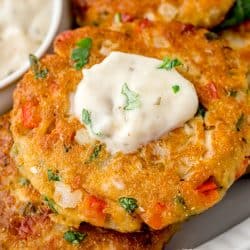
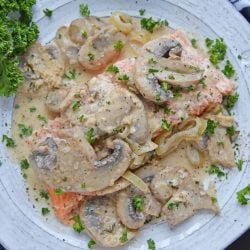
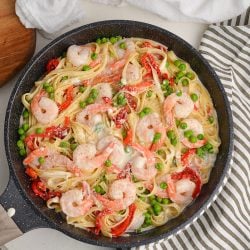
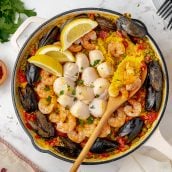
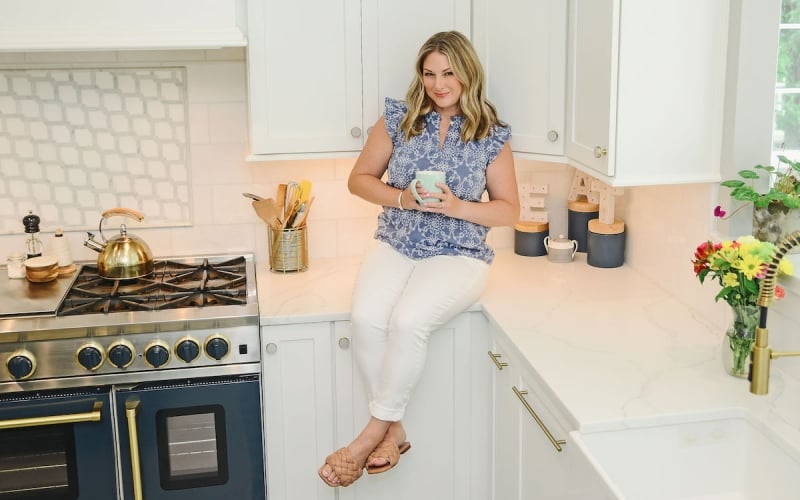
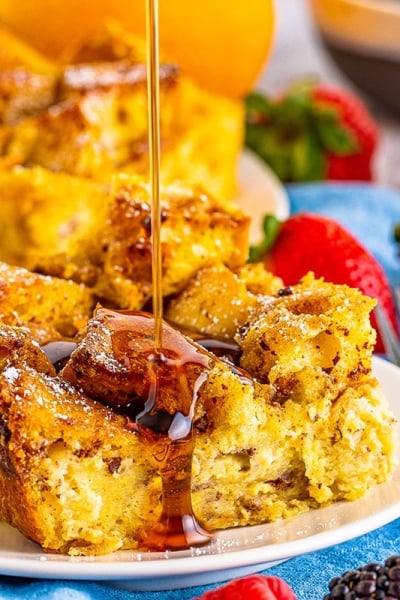
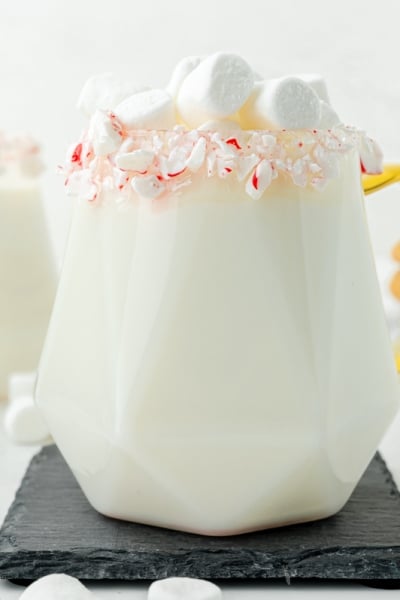
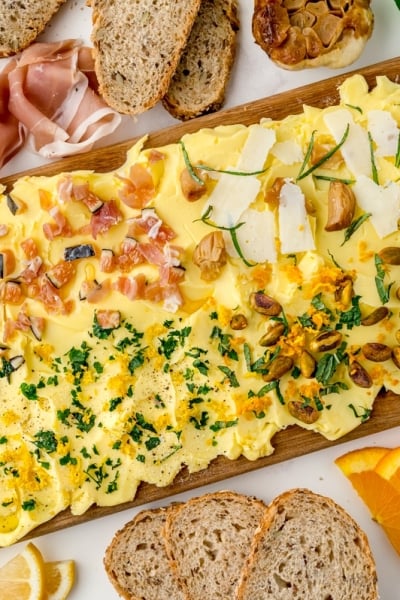
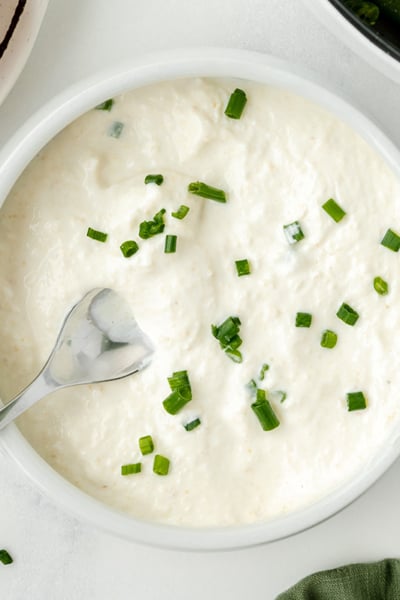













That looks delicious! I love shrimp and scallops!
Oh my husband would go gaga for this! I have printed it and will be trying it out! Thanks for sharing!
Paella is absolutely amazing! Thanks for sharing this classic dish
Great looking recipe. I love to cook with fresh saffron.
We actually don’t eat seafood in our house. I know, I know….a New Englander who doesn’t like seafood lol.
Robin, I’m amazed every time you say this! The good news is that paella can also be made with chicken or sausage- just cook it up ahead of time and use chicken stock/broth.
That looks so amazingly good! I love paella but have never tried to make it on our own.
When my boyfriend and I were in Spain, we took a paella & sangria cooking class. It was so awesome! We didn’t actually cook the paella ourselves but we were led through a market to pick out all the fresh ingredients and then were shown how to make it (but the chef made it in a huge pan for everyone). It was one of my favorite experiences I had in Spain. Paella is so tasty!!
I love cooking seafood! This looks great, can’t wait to try it
YUM! This looks so good! I’m always afraid to make seafood for some reason.
I have not tried that I guess. Interesting and looks good.